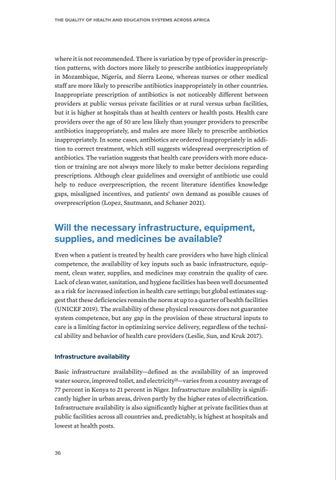The Quality of Health and Education Systems Across Africa
where it is not recommended. There is variation by type of provider in prescription patterns, with doctors more likely to prescribe antibiotics inappropriately in Mozambique, Nigeria, and Sierra Leone, whereas nurses or other medical staff are more likely to prescribe antibiotics inappropriately in other countries. Inappropriate prescription of antibiotics is not noticeably different between providers at public versus private facilities or at rural versus urban facilities, but it is higher at hospitals than at health centers or health posts. Health care providers over the age of 50 are less likely than younger providers to prescribe antibiotics inappropriately, and males are more likely to prescribe antibiotics inappropriately. In some cases, antibiotics are ordered inappropriately in addition to correct treatment, which still suggests widespread overprescription of antibiotics. The variation suggests that health care providers with more education or training are not always more likely to make better decisions regarding prescriptions. Although clear guidelines and oversight of antibiotic use could help to reduce overprescription, the recent literature identifies knowledge gaps, misaligned incentives, and patients’ own demand as possible causes of overprescription (Lopez, Sautmann, and Schaner 2021).
Will the necessary infrastructure, equipment, supplies, and medicines be available? Even when a patient is treated by health care providers who have high clinical competence, the availability of key inputs such as basic infrastructure, equipment, clean water, supplies, and medicines may constrain the quality of care. Lack of clean water, sanitation, and hygiene facilities has been well documented as a risk for increased infection in health care settings; but global estimates suggest that these deficiencies remain the norm at up to a quarter of health facilities (UNICEF 2019). The availability of these physical resources does not guarantee system competence, but any gap in the provision of these structural inputs to care is a limiting factor in optimizing service delivery, regardless of the technical ability and behavior of health care providers (Leslie, Sun, and Kruk 2017).
Infrastructure availability Basic infrastructure availability—defined as the availability of an improved water source, improved toilet, and electricity14—varies from a country average of 77 percent in Kenya to 21 percent in Niger. Infrastructure availability is significantly higher in urban areas, driven partly by the higher rates of electrification. Infrastructure availability is also significantly higher at private facilities than at public facilities across all countries and, predictably, is highest at hospitals and lowest at health posts.
36


